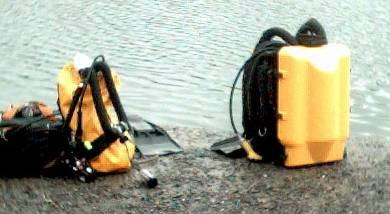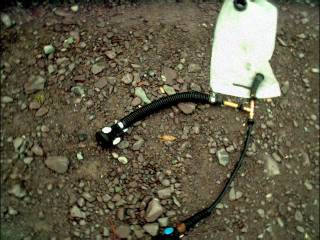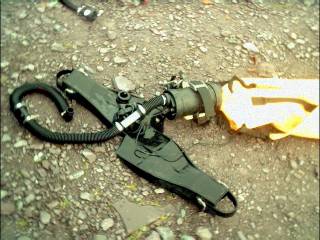7th November 2004
The Yellow Bag of Doom
(or a remote control rebreather)
| After deciding
to go down the route of a sidemount rebreather last weekend I developed
the idea a bit further. The ADV did not work especially well so I tried
something new. I also added a connection for the oxygen metering valve.
One of the problems I hit last week was that the controls were hard to
reach on the side of the bag so I built a remote control system for manually
adding diluent and O2.
The final step
is to house the whole system in a caving tackle bag. The picture shows
my yellow bag of doom next to someone else's yellow box of death. The bag
has a couple of loops which allow it to be clipped on at the waist and
shoulder. |
 |
 |
Here is the
remote control system. These are push-button valves on the end of a length
of LP hose. The valve with the blue button is the manual oxygen addition
valve and the other is the combined ADV and manual diluent addition valve.
They are tee'd together using Swagelok parts and fed into the counterlung
with a Lapp gland.
The diluent
valve is combined with an ADV. This is a modified Scubapro AIR II. The
mouthpiece and exhaust valves have been sealed and the dump valve modified
so that air would flow through the corrugated hose rather than the mouthpiece.
If the counterlung bottoms out during a breath then the diaphragm on the
AIR II flexes on the lever and opens the 2nd stage valve. On my backmounted
twinset I replaced the back-up regulator with a large bore Scubapro quick
release to connect to the diluent valve. |
| This shows
the rest of the guts of the rebreather and its yellow bag of doom (the
fins are not part of it). The grey tube spliced into the corrugated loop
hose is to extend the inhale side to compensate for the length of the counterlung
in the exhale side. |
 |
The tackle sack
idea was good but too bulky, I need something narrower. Also the bag seemed
to restrict the counterlung in the water, it was far easier (and easier
to manage) with the scrubber and counterlung attached on their own with
no cover. The dive went well apart from the restricted lung. The ADV functioned
as planned and the remote controls worked but they need thought through
as to hose routing and where to attach them.
Again, the electronics
worked perfectly too. Flushes with both diluent and oxygen underwater gave
a displayed ppO2 exactly as predicted. One big problem that I hit was that
I did not connect the O2 metering valve because I wanted to run the rebreather
manually for testing. What I forgot was that the attachment for it was
a drysuit inflation valve that had been modified to be always open. Without
the metering valve connected then the counterlung was essentially open
to the water. I remembered this during the dive when I started to hear
a gurgle. As the dive went on the gurgling got worse so I abandoned the
dive because I wasn't sure how the rebreather would react. With the backmount
rebreather the lungs acted as water traps but on the sidemounted rebreather
I did not have that feature. The scrubber was still functioning but when
I removed the p-plug on the bottom about 1/2 a litre of caustic water poured
out (I knew it was caustic because every tiny scratch I had on my hand
started to burn like fire). Not good. I need to come up with something
to get water out of the loop. In this configuration there is nothing to
stop any water entering the counterlung to straight to the scrubber, down
the exhale pipe and pool in the bottom of it until either it creates a
breakthrough channel or starts finding its way up the inhale hose.


